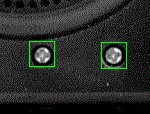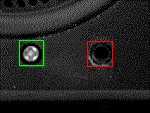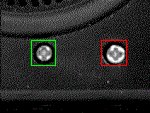Application Specific Systems:
• Wood Product Inspection Systems
•
Printing & Finish Inspection Systems
• Metal Part Inspection Systems
• Thread Analysis & Inspection Systems
• Bearing Assembly Inspection Systems
• Bearing Race Inspection Systems
• Automotive Control Arm Inspection System
• Manifold & Crossover Inspection Systems
• Assembly Inspection Systems
• Battery Inspection Systems
• Tablet, Capsule, and Pill Inspection Systems
• Circuit Board Component Assembly Inspection Systems
• Packaged Liquid Product Inspection Systems
• Caps & Closures Inspection Systems
• Gravity Belt Thickener Controls
• Ultra-Accurate Automatic Gauging Systems
Screws in Plastic Casing
In this sample application, we present two ways to detect the presence of screws in the plastic casing of a portable cassette player.
The important point in this application is the essential equivalence of image objects and regions of interest in NeuroCheck. Many people fail to see this, because
it is such a new and unusual way of thinking, but in our eyes, this really constitutes object-oriented image processing: not simply programming in a certain
language, but using a consistent object model throughout each image processing function. Only in this manner you can reach the degree of interoperability and
interactivity offered by NeuroCheck and create a system, in which each building block can work together with all the others to achieve hitherto unknown flexibility.

All screws present |

One screw missing |

One screw unfastened |
The most obvious way for people familiar with NeuroCheck would be to search for the dark casing, which is kind of hard to miss, then go on searching for light
objects within the casing, compute some features of these objects (like their size and area and shape parameters) and decide, whether two of them are the required
screws. This is of course a perfectly viable solution, but the twofold object search and the evaluation of the objects take some time: 60 milliseconds on a
Pentium 133 (not including image capturing, whose duration with a standard camera may vary within the video frame rate).
But it can be done within 16 milliseconds by using a vertical edge as position reference to place two regions of interest where the screws have to appear in the
image. The presence of the screws can then easily be determined by the brightness inside the rectangle. It is even possible to detect a partly unfastened screw,
because it sticks out and reflects too much light. Combine this with a DT3152 frame grabber and NeuroCheck's parallel image capturing capability and you get a
real-time inspection!
Once again: whatever you can do with an object found in the image scene, you can also do with a manually defined region of interest. Of course, manual regions will
behave differently in some respects, e.g. their position and size are fixed, but in all practical aspects they can be interchanged, and this is the cornerstone of
the NeuroCheck's versatility.
We do not want to deny that there are other, more traditional ways of performing such an inspection. It is of course possible and at first sight perhaps even cheaper
to build a mechanical solution, using two inductive calipers or something like that. But think of the future! A day will come, most probably not very far away, when
the screws will be at a different position. You would be forced to a costly and time-consuming reconstruction of the mechanics, whereas moving the regions of
interest in NeuroCheck is a matter of minutes. And it does not end there: the next day someone will want an inscription on the casing to be read, and how will you
do that with a caliper?


